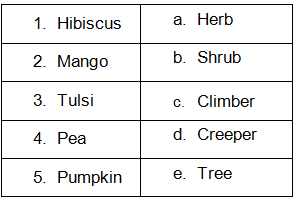Plants Around Us - 1 Class 2 Worksheet Science
Q1: Tick (✓) the correct choice.
(i) This plant crawls along the ground.
(a) Climber
(b) Creeper
(c) Herb
Ans: (a)
Creepers are plants with weak stems and which are found crawling on the ground.
(ii) This plant grows in water.
(a) Cactus
(b) Bottle gourd
(c) Lotus
Ans: (c)
Some of the water plants have floating leaves like Lotus and some are completely submerged under water like Hydrilla. Examples: - Water lily, Water-chestnut, Lotus.

(iii) These plants live for a few months.
(a) Trees
(b) Shrubs
(c) Herbs
Ans: (c)
Most herbs live only for a few months. Grass, mint, wheat, sunflower, lady's finger, etc., are herbs. Herbs are smaller than shrubs. They have soft, green and thin stems.
(iv) These are small plants with soft stems.
(a) Shrubs
(b) Climbers
(c) Herbs
Ans: (c)
The herbs are small plants with a soft stem. Wheat, cabbage, paddy, coriander, grass, etc are examples.
Q2: Fill in the Blanks

(i) ______ give a bushy appearance.
Ans: Shrubs give a bushy appearance.
Plants that are shorter than trees and a bushy appearance are known as shrubs. Shrubs are small to medium-sized Woody plants which persist Woody stems above the ground. They are differentiated by trees in terms of height and multiple stems.
(ii) The stem of a _________ is hard and thick, and is called the trunk.
Ans: The stem of a trees is hard and thick, and is called the trunk.
Trees are big, tall and strong plants. They have a thick, brown and woody stem called trunk. They have many branches that bear leaves, flowers and fruits.
(iii) ________ are smaller than shrubs.
Ans: Herbs are smaller than shrubs.
Herbs are smaller than shrubs. Have a single stem. Usually have multiple branches. Have delicate and thin tissue.
Q3: True and False
(i) Plants cannot grow in hot places like the desert.
Ans: False
Plants that grow well in desert environments need to store moisture in their fleshy leaves or have an extensive root system. Cacti are the most common desert plants.
(ii) Shrubs generally live for a few years.
Ans: False
Most herbs live only for a few months. Grass, mint, wheat, sunflower, lady's finger, etc., are herbs. Herbs are smaller than shrubs. They have soft, green and thin stems.
(iii) Trees are tall and strong.
Ans: True
Trees are big, tall and strong plants. They have a thick, brown and woody stem called trunk. They have many branches that bear leaves, flowers and fruits.

Q4: Match the following

Ans: Hibiscus - shrub
Hibiscus are deciduous shrubs with dark green leaves; the plants can grow to 15 feet tall in frost-free areas
Mango - tree
Trees have hard and thick stems called trunk, such as mango and coconut.
Tulsi - herb
Tulsi is considered a herb, it can help adapt the body to stress and boost energy.
Pea - Climber
Pea plants are climbers. Climbers are plants that require support because they have weak stems.
Pumpkin - Creeper
Pumpkin is a creeper plant because it's fruit is big and it cannot climb to other trees or wood so it is creeper and not a climber.
Q5: Short Questions Answer
(i) Which plants usually live longer—trees or shrubs?
Ans: Trees are big, tall and strong plants. They have a thick, brown and woody stem called trunk. Shrubs are small to medium-sized woody plants and may grow up to height of five to six metres. Trees usually live longer than shrubs.
(ii) Name the different types of plants.
Ans: Different types of plants are:
- Herbs: The herb is a short-sized plant with soft, green, delicate stem without the woody tissues.
- Shrubs: Shrubs are medium-sized, woody plants taller than herbs and shorter than a tree.
- Trees: Trees are big and tall plants. They have very thick, woody and hard stems called the trunk.
|
13 videos|80 docs|24 tests
|
FAQs on Plants Around Us - 1 Class 2 Worksheet Science
| 1. What are some common types of plants found around us? |  |
| 2. How do plants around us benefit the environment? |  |
| 3. What are the essential requirements for plants to grow and survive? |  |
| 4. How do plants reproduce? |  |
| 5. How can we take care of the plants around us? |  |

|
Explore Courses for Class 2 exam
|

|












